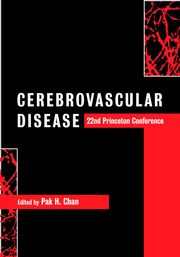Book contents
- Frontmatter
- Contents
- List of contributors
- Preface
- Acknowledgments
- Part I Special lectures
- Part II Oxidative stress
- Part III Apoptosis
- Part IV Hot topics
- Part V Hemorrhage, edema and secondary injury
- 14 The role of matrix metalloproteinases and urokinase in blood–brain barrier damage with thrombolysis
- 15 Does brain nitric oxide generation influence tissue oxygenation after severe human subarachnoid hemorrhage?
- 16 Tissue plasminogen activator and hemorrhagic brain injury
- 17 Dynamics of infarct evolution after permanent and transient focal brain ischemia in mice
- Part VI Inflammation
- Part VII Gene transfer and therapy
- Part VIII Neurogenesis and plasticity
- Part IX Magnetic resonance imaging in clinical stroke
- Part X Risk factors, clinical trials and new therapeutic horizons
- Index
- Plate section
14 - The role of matrix metalloproteinases and urokinase in blood–brain barrier damage with thrombolysis
from Part V - Hemorrhage, edema and secondary injury
Published online by Cambridge University Press: 02 November 2009
- Frontmatter
- Contents
- List of contributors
- Preface
- Acknowledgments
- Part I Special lectures
- Part II Oxidative stress
- Part III Apoptosis
- Part IV Hot topics
- Part V Hemorrhage, edema and secondary injury
- 14 The role of matrix metalloproteinases and urokinase in blood–brain barrier damage with thrombolysis
- 15 Does brain nitric oxide generation influence tissue oxygenation after severe human subarachnoid hemorrhage?
- 16 Tissue plasminogen activator and hemorrhagic brain injury
- 17 Dynamics of infarct evolution after permanent and transient focal brain ischemia in mice
- Part VI Inflammation
- Part VII Gene transfer and therapy
- Part VIII Neurogenesis and plasticity
- Part IX Magnetic resonance imaging in clinical stroke
- Part X Risk factors, clinical trials and new therapeutic horizons
- Index
- Plate section
Summary
Introduction
Recombinant tissue plasminogen activator (rtPA) benefits patients who have had an acute stroke, but a delay in treatment for over 3 hours raises the risk of intracerebral hemorrhage. Reperfusion of blood into an ischemic region, while preserving metabolic function, results in the production of molecules that may damage the injured tissue. The cerebral microvasculature is a major site of injury during reperfusion with a biphasic disruption of the blood–brain barrier (BBB) seen after reperfusion. Multiple factors have been implicated in the damage to the microvasculature by ischemia with reperfusion, including free radicals, blood products and proteases. Matrix metalloproteinases (MMPs) are a gene family of neutral proteases. Once formed and activated, the MMPs attack the basal lamina around the cerebral blood vessels, leading to the opening of the BBB. MMPs are induced in cerebral ischemia.
MMPs are secreted in a latent form that requires activation. Plasminogen activators (PAs) are serine proteases involved in angiogenesis, neuronal growth and regulation of other proteases through activation processes. Brain cells produce PAs in response to an ischemic injury. Urokinase-type plasminogen activator (uPA) is secreted by microglial cells in culture. Urokinase generates plasmin, which activates MMPs. Latent MMP-2 (gelatinase A) is activated by a membrane-type metalloproteinase (MT-MMP), which is activated by plasmin. Latent MMP-9 (gelatinase B) is activated by stromelysin-1 (MMP-3), which also requires plasmin for activation.
- Type
- Chapter
- Information
- Cerebrovascular Disease22nd Princeton Conference, pp. 161 - 171Publisher: Cambridge University PressPrint publication year: 2002



